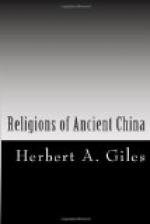CHAPTER IV — MATERIALISM
Yang Hsiung.—Yang Hsiung was a philosopher who flourished B.C. 53 — A.D. 18. He taught that the nature of man at birth is neither good nor evil, but a mixture of both, and that development in either direction depends wholly upon environment. To one who asked about God, he replied, “What have I to do with God? Watch how without doing anything He does all things.” To another who said, “Surely it is God who fashions and adorns all earthly forms,” he replied, “Not so; if God in an earthly sense were to fashion and adorn all things, His strength would not be adequate to the task.”
Wang Ch’ung.—Wang Ch’ung, A.D. 27-97, denies that men after death live again as spiritual beings on earth. “Animals,” he argues, “do not become spirits after death; why should man alone undergo this change? . . . That which informs man at birth is vitality, and at death this vitality is extinguished. Vitality is produced by the pulsations of the blood; when these cease, vitality is extinguished, the body decays, and becomes dust. How can it become a spirit? . . . When a man dies, his soul ascends to heaven, and his bones return (kuei) to earth; therefore he is spoken of as a disembodied spirit (kuei), the latter word really meaning that which has returned. . . . Vitality becomes humanity, just as water becomes ice. The ice melts and is water again; man dies and reverts to spirituality. . . . The spirits which people see are invariably in the form of human beings, and that very fact is enough of itself to prove that these apparitions cannot be the souls of dead men. If a sack is filled with grain, it will stand up, and is obviously a sack of grain; but if the sack is burst and the grain falls out, then it collapses and disappears from view. Now, man’s soul is enfolded in his body as grain in a sack. When he dies his body decays and his vitality is dissipated; and if when the grain is taken away the sack loses its form, why, when the vitality is gone, should the body obtain a new shape in which to appear again in the world? . . . The number of persons who have died since the world began, old, middle-aged, and young, must run into thousands of millions, far exceeding the number of persons alive at the present day. If every one of these has become a disembodied spirit, there must be at least one to every yard as we walk along the road; and those who die must now suddenly find themselves face to face with vast crowds of spirits, filling every house and street. . . . People say that spirits are the souls of dead men. That being the case, spirits should always appear naked, for surely it is not contended that clothes have souls as well as men. . . . It can further be shown not only that dead men never become spirits, but also that they are without consciousness, by the fact that before birth they are without consciousness. Before birth man rests in the First Cause; when he dies he




